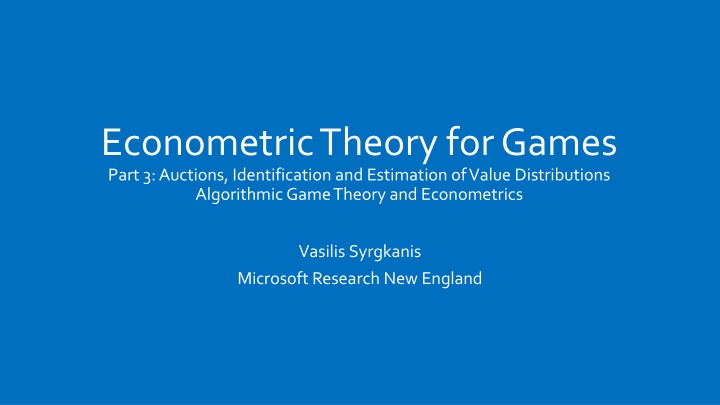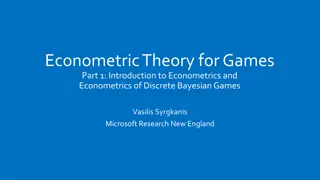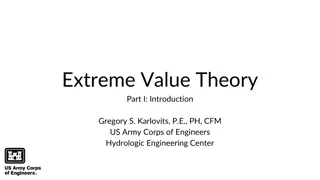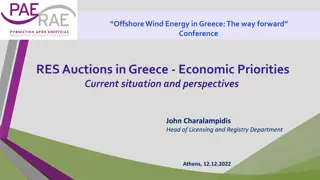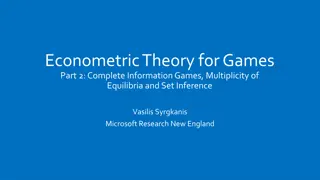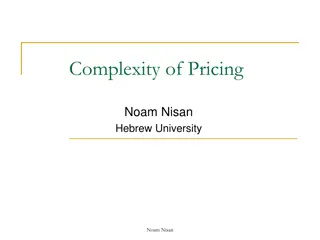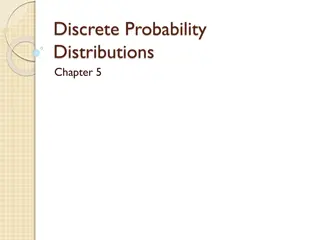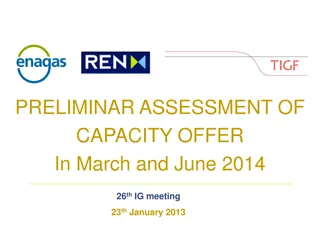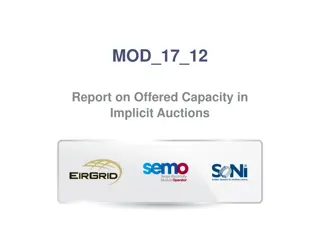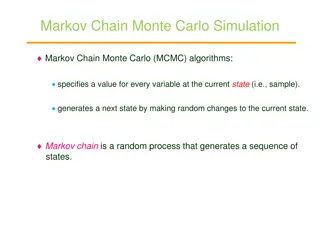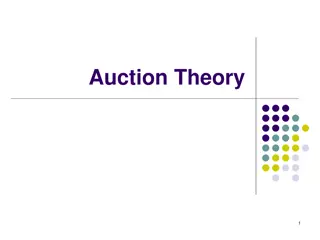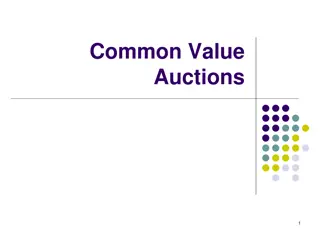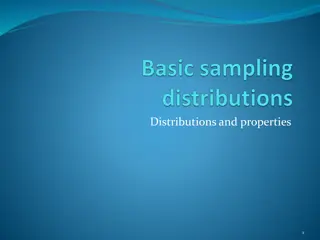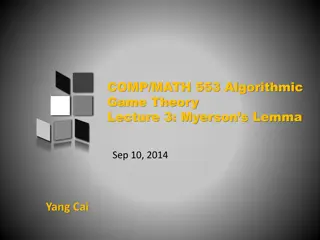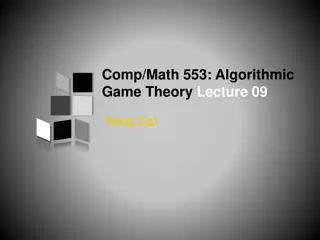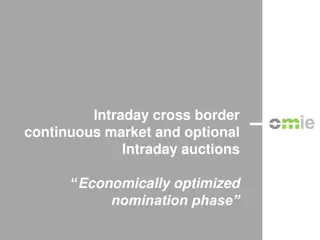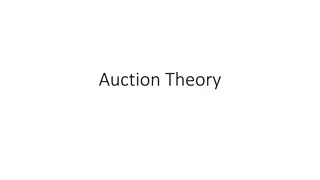Econometric Theory for Auctions and Value Distributions
Delve into the world of auction theory, identification, and estimation of value distributions in econometrics. Explore non-parametric identification and estimation techniques in first-price auctions. Gain insights into algorithmic game theory and econometrics with a focus on structural estimation in auctions.
Download Presentation

Please find below an Image/Link to download the presentation.
The content on the website is provided AS IS for your information and personal use only. It may not be sold, licensed, or shared on other websites without obtaining consent from the author.If you encounter any issues during the download, it is possible that the publisher has removed the file from their server.
You are allowed to download the files provided on this website for personal or commercial use, subject to the condition that they are used lawfully. All files are the property of their respective owners.
The content on the website is provided AS IS for your information and personal use only. It may not be sold, licensed, or shared on other websites without obtaining consent from the author.
E N D
Presentation Transcript
Econometric Theory for Games Part 3: Auctions, Identification and Estimation of Value Distributions Algorithmic Game Theory and Econometrics Vasilis Syrgkanis Microsoft Research New England
Auction Games: Identification and Estimation FPA IPV:[Guerre-Perrigne-Vuong 00], Beyond IPV:[Athey-Haile 02] Partial Identification:[Haile-Tamer 03] Comprehensive survey of structural estimation in auctions: [Paarsch-Hong 06]
First Price Auction: Non-Parametric Identification [Guerre-Perrigne-Vuong 00] Sealed bid first price auction Symmetric bidders: value ?? ? Observe all submitted bids Bids come from symmetric Bayes-Nash equilibrium Non-parametric identification:Can we identify ? from the distribution of bids ??
First Price Auction: Non-Parametric Identification [Guerre-Perrigne-Vuong 00] At symmetric equilibrium ?( ): ? ? ? ?? 1(?) ? = argmax ? First-order-condition: ? ? ? ? ? 1 ?(?) ? 1 ? ? ?? 2? = ? ? ?? 1? ? = ? ? + ? ? ? By setting ? = ?(?): ? ? = Pr ? ? = Pr ? ? 1? = ? ? 1? =? ? 1(?) ? ? 1? ? ? = ? ? 1? Change variables ? = ? 1(?) in FOC: ? ? ? 1? = ? + ? 1 ? ?
First Price Auction: Non-Parametric Identification [Guerre-Perrigne-Vuong 00] ? ? hidden value ? = ? 1? = ? + = ?(?,?) ? 1 ? ? If distribution of values is nice (continuous and with continuous density) then ? 1? and ?(?,?) are invertible: ? ? = ? ? 1?,? ? can be identified when having access to G!
First Price Auction: Non-Parametric Estimation [Guerre-Perrigne-Vuong 00] ? ? Sequence of bid samples from each player ??? ?=1 Estimate ? and ? non-parametrically via standard approaches ? is empirical CDF: ? b = n ? ?=1 1 1{??? ?} ?,? ? is a kernel-based estimator: 1 1 ?? ??? ? ? ? b = n ? ?,? ? is any density function with zero moments up to ? and bounded ?- th moment
First Price Auction: Non-Parametric Estimation Given ? and ? we can now find the pseudo-inverse value of the player Use empirical version of identification formula [Guerre-Perrigne-Vuong 00] ?(Bit) n 1 g Bit ???= ???+ Similarly define second-stage estimators of ? and ?:** ? v = 1 1{ ??? ?} n ? ?,? ??? ? ? 1 1 ?? ? v = n ? ?,? ** Need some modifications if one wants unbiasedness
Uniform Rates of Convergence Suppose ? has ? uniformly bounded continuous derivatives ? 2?+1 ? If we observed values then uniform convergence rate of log ? From classic results in non-parametric regression [Stone 82] Now that only bids are observed, [GPV 00] show that best achievable 2?+3 ? ? is: log ? The density f depends on the derivative of g
What if only winning bid is observed? For instance in a Dutch auction CDF of winning bid is simply: 1 ? ??? = ? ?? ? ? = ??? Hence, densities are related as: ? ? =1 1 ? 1 ???? ??? Thus ? and ? are identified from ?? and ?? Hence, can apply previous argument and identify ? and ?
What if only winning bid is observed? Alternatively, we can identify value of winner as: 1 ? ?? ? ?? ? ???? ???? ??= ??+ = ??+ ? 1 ? 1 Thus we can identify distribution of highest value ?? and ?? 1 ? and ? ? = Subsequently, use F ? = ??? 1 ???? ??? This also gives an estimation strategy (two-stage estimator, similar to case when all bids observed) 1 ? 1 to identify ? and ?
Notable Literature [Athey-Haile 02] Identification in more complex than independent private values setting. Primarily second price and ascending auctions Mostly, winning price and bidder is observed Most results in IPV or Common Value model [Haile-Tamer 03] Incomplete data and partial identification Prime example: ascending auction with large bid increments Provides upper and lower bounds on the value distribution from necessary equilibrium conditions [Paarsch-Hong 06] Complete treatment of structural estimation in auctions and literature review Mostly presented in the IPV model
Main Take-Aways Closed form solutions of equilibrium bid functions in auctions Allows for non-parametric identification of unobserved value distribution Easy two-stage estimation strategy (similar to discrete incomplete information games) Estimation and Identification robust to what information is observed (winning bid, winning price) Typically rates for estimating density of value distribution are very slow
Algorithmic Game Theory and Econometrics Mechanism Design for Inference Econometrics for Learning Agents
Mechanism Design for Data Science [Chawla-Hartline-Nekipelov 14] Aim to identify a class of auctions such that: By observing bids from the equilibrium of one auction Inference on the equilibrium revenue on any other auction in the class is easy Class contains auctions with high revenue as compared to optimal auction Class analyzed: Rank-Based Auctions Position auction with weights ?1 ?? ??+1= 0 Bidders are allocated randomly to positions based only the relative rank of their bid k-th highest bidder gets allocation ?? Pays first price: ???? Feasibility: ?=1 ?? ?=1 ?? For regular distributions, best rank-based auction is 2-approx. to optimal ? ?
Optimizing over Rank-Based Auctions [Chawla-Hartline-Nekipelov 14] Every rank-based auction can be viewed as a new position auction with weights: ?? satisfying ?=1 ?? ?=1 Thus auctioneer s optimization is over such modifications to the setting Each of these auctions is equivalent to running a mixture of k-unit auctions, where k-th unit auction run w.p. ??= ?? ??+1 To calculate revenue of any rank based auction, suffices to calculate expected revenue ?? of each k-th unit auction Main question. Estimation rates of quantity ?? when observing bids from a given rank-based auction ? ? ??
Estimation analysis [Chawla-Hartline-Nekipelov 14] Similar to the FPA equilibrium characterization used by [GPV 00] As always, write everything in quantile space With a twist: ? = ?(?) At symmetric equilibrium ?( ): ?(?) = argmax ? FOC: ? ? = ? ? +? ? ? ? ?(?) ? ? ? 1? ? (?) ? ? and ? (?) are known from the rules of the auction
Estimation [Chawla-Hartline-Nekipelov 14] Need to estimate ?(?) and ? (?) if we want to estimate ?(?) Compared to [GPV 00]: ? ? = ? 1(?) ? ? = ? 1(?), ? ? = ? ? 1? Estimating ? ? ,? ? ,? ? the same as estimating ?,?,? 1 Main message. The quantity ?? for any ? depends only on ? ? and not on ? ? ! Leads to much faster rates.
Fast Convergence for Counterfactual Revenue [Chawla-Hartline-Nekipelov 14] The per agent revenue of a k-unit auction can be written as: ? ? ? ? ?? ? ? = ? ? 1 ? : single buyer revenue from price ? ? ??(?): probability player with quantile ? is among ?-highest Remember ? ? = ? ? +? ? ? ? Dependence on ? ? is of the form: 1 ? convergence* of Yields ? MSE, since ?(?) is essentially a CDF inverted ? (?) ? ? ? 1 ? ?? ? ? ? ? ? *Exact convergence depends inversely on ? ? Need to restrict to rank-based auctions where ? ? > ? (e.g. mixing each k-unit auction with probability ?/?) Integrating by parts: ? ? ? 1 ? ?? ? ? ? ? ? which depends only on ?(?)and on exactly known quantities
Take-away points [Chawla-Hartline-Nekipelov 14] By isolating mechanism design to rank based auctions, we achieve: Constant approximation to the optimal revenue within the class Estimation rates of revenue of each auction in the class of ? ? Allows for easy adaptation of mechanism to past history of bids [Chawla et al. EC 16]: allows for A/B testing among auctions and for a universal B test! (+improved rates)
Econometrics for Learning Agents [Nekipelov-Syrgkanis-Tardos 15] Analyze repeated strategic interactions Finite horizon ? 1, ,? Players are learning over time Unlike stationary equilibrium, or stationary MPE, or static game Use no-regret notion of learning behavior: ?,? ? ?;?) ?;? ? : ,? ? ?? ??(?? ???? ? ?
High-level approach [Nekipelov-Syrgkanis-Tardos 15] If we assume ? regret 1 ? ????;? 1 : ,? ? ?;? ? For all ?? ? ???? ? ? Current average utility Regret Average deviating utility from fixed action ? rationalizable set Inequalities that unobserved ? must satisfy Varying ? we get the rationalizable set of parameters ? ? ? ?
Application: Online Ad Auction setting [Nekipelov-Syrgkanis-Tardos 15] Each player has value-per-click ?? Bidders ranked according to a scoring rule Number of clicks and cost depends on position Quasi-linear utility Value-Per-Click Expected Payment ???;?? = ?? ??? ??? Expected click probability
Main Take-Aways of Econometric Approach [Nekipelov-Syrgkanis-Tardos 15] Rationalizable set is convex Support function representation of convex set depends on a one dimensional function Can apply one-dimensional non-parametric regression rates Avoids complicated set-inference approaches Comparison with prior econometric approaches: Behavioral learning model computable in poly-time by players Models error in decision making as unknown parameter rather than profit shock with known distribution Much simpler estimation approach than prior repeated game results Can handle non-stationary behavior
Potential Points of Interaction with Econometric Theory Inference for objectives (e.g. welfare, revenue, etc.) + combine with approximation bounds (see e.g. Chawla et al 14-16, Hoy et al. 15, Liu- Nekipelov-Park 16,Coey et al. 16) Computational complexity of proposed econometric methods, computationally efficient alternative estimation approaches Game structures that we have studied exhaustively in theory (routing games, simple auctions) Game models with combinatorial flavor (e.g. combinatorial auctions) Computational learning theory and online learning theory techniques for econometrics Finite sample estimation error analysis
AGT+Data Science Large scale mechanism design and game theoretic analysis needs to be data-driven Learning good mechanisms from data Inferring game properties from data Designing mechanisms for good inference Testing our game theoretic models in practice (e.g. Nisan-Noti 16)
References Auctions Guerre-Perrigne-Vuong, 2000: Optimal non-parametric estimation of first-price auctions, Econometrica Haile-Tamer, 2003: Inference in an incomplete model of English auctions, Journal of Political Economy Athey-Haile, 2007: Non-parametric approaches to auctions, Handbook of Econometrics Paarsch-Hong, 2006: An introduction to the structural econometrics of auction data, The MIT Press Algorithmic Game Theory and Econometrics Chawla-Hartline-Nekipelov, 2014: Mechanism design for data science, ACM Conference on Economics and Computation Nekipelov-Syrgkanis-Tardos, 2015: Econometrics for learning agents, ACM Conference on Economics and Computation Chawla-Hartline-Nekipelov, 2016: A/B testing in auctions, ACM Conference on Economics and Computation Hoy-Nekipelov-Syrgkanis, 2015: Robust data-driven guarantees in auctions, Workshop on Algorithmic Game Theory and Data Science
